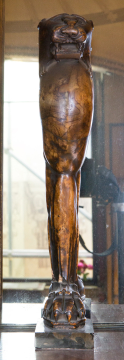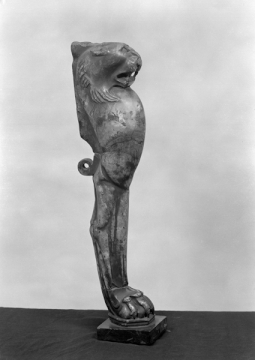Explore Collections


You are here:
CollectionsOnline
/
Lion monopodium leg from a Roman tripod stand or table
Browse
Lion monopodium leg from a Roman tripod stand or table
Brown alabaster
Height: 52cm
Length (side): 13cm
Length (side): 13cm
Museum number: BR13
On display: Breakfast Room
All spaces are in No. 13 Lincoln's Inn Fields unless identified as in No. 12, Soane's first house.
For tours https://www.soane.org/your-visit
Curatorial note
The leg is carved into an Abyssinian lion's head at the top, curves outwards from a vertical backing ending in a carved ring, and terminates in a paw at the foot.
The character of the rectangular backing and the bracket ring suggest the use of this type of leg in tripod arrangements rather than for four-legged tables. The fastening loop is too delicate to have enabled the leg to have been used in a chair1.
An amusing variant of the standard Roman decorative animal-form furniture leg is a table leg in the Louvre, Paris, with reserves formed of the head and body of a Seilenos with hands on hips and terminating in the conventional lion's paw. The so-called 'Throne of Dagobert I' in the Bibliothèque Nationale, Paris, a folding-type curule throne, shows the use of this animal-foot motive in furniture of the early Middle Ages2. In the other chronological direction, a small Archaic ivory from Corinth shows that the trapezephoros form had evolved in Greek art prior to its widespread Hellenistic use3.
1 Compare H.S. Jones, Catalogue of Ancient Sculptures Preserved in the Municipal Collections of Rome: Museo Capitolino, Oxford, 1912, p. 156, Sala Delle Colombe, no. 42, pl. 35, for a similar 'Tripod, or table leg' found c.1743 in a vineyard belonging to S. Croce in Gerusalemme, Rome.
2 G. Janneau, Les Sièges, Paris, 1967, I, p. 18, fig. 7.
3 American Journal of Archaeology XXIX, 1925, p. 391, pl. IV.
The character of the rectangular backing and the bracket ring suggest the use of this type of leg in tripod arrangements rather than for four-legged tables. The fastening loop is too delicate to have enabled the leg to have been used in a chair1.
An amusing variant of the standard Roman decorative animal-form furniture leg is a table leg in the Louvre, Paris, with reserves formed of the head and body of a Seilenos with hands on hips and terminating in the conventional lion's paw. The so-called 'Throne of Dagobert I' in the Bibliothèque Nationale, Paris, a folding-type curule throne, shows the use of this animal-foot motive in furniture of the early Middle Ages2. In the other chronological direction, a small Archaic ivory from Corinth shows that the trapezephoros form had evolved in Greek art prior to its widespread Hellenistic use3.
1 Compare H.S. Jones, Catalogue of Ancient Sculptures Preserved in the Municipal Collections of Rome: Museo Capitolino, Oxford, 1912, p. 156, Sala Delle Colombe, no. 42, pl. 35, for a similar 'Tripod, or table leg' found c.1743 in a vineyard belonging to S. Croce in Gerusalemme, Rome.
2 G. Janneau, Les Sièges, Paris, 1967, I, p. 18, fig. 7.
3 American Journal of Archaeology XXIX, 1925, p. 391, pl. IV.
Rome; collected in Rome by Charles Heathcote Tatham for the architect Henry Holland during the 1790s. See Cornelius Vermeule, unpublished catalogue of the Antiquities at Sir John Soane's Museum, Introduction, transcription of Tatham letters, List 1, no. 30.
Literature
Tatham: Etchings, 2; Drawings, 6. See drawings SM Vol. 98_6 and Vol. 100_22
Associated items
BR14, cast
Soane collections online is being continually updated. If you wish to find out more or if you have any further information about this object please contact us: worksofart@soane.org.uk





